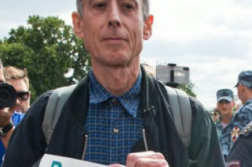THE FOLLOWING is based upon my personal observations of Saudi Arabian society as an English language teacher over a four-year period. Throughout my time in Saudi I lived in four cities: Jubail, Dammam, Medina, and Riyadh.
The first thing one notices in Saudi Arabia is the segregation of the sexes, which is virtually complete in both public and private arenas. Only once did I enter a Saudi house and see a mother and daughter unveiled. One leading advisor to King Abdullah did utter a recent pronouncement that a man could fraternize with a woman who was not his wife only if he took some of her breast milk. Another scholar, worried about the increase of women going out in public on their own, advocated that groping such transgressors should be a male Muslim’s duty.
Consequently, men and boys grow up in highly homosocial environments. Not surprisingly, same-sex acts and relationships abound. To be sure, the punishment for homosexual acts under Shari’a law is death by beheading. However, in the four years that I was there (2009-2013), there were no executions; nor were there any significant clampdowns on expressions of homosexuality that I was aware of.
In my four years in Saudi Arabia, I personally was propositioned on the street by three men and by many of my students. I knew of several Westerners who were in gay relationships with Saudi men, and two active gay male circles. There is also a well-known Starbucks coffeehouse in the center of Riyadh that’s known as a gay meeting place, where many an expatriate has picked up a partner for casual sex. One very straight Saudi student of mine bemoaned the fact that “Saudi Arabia has too many gays, over twenty percent.” One of my eighteen-year-old students was in love with Justin Bieber and said he had no need of women.
Certainly Saudi Arabia shares many features with other Middle Eastern and North African societies. For example, it is quite acceptable for young men to hold hands in public, peck each other on the cheek, spray each other with Oud (male perfume), and even enter into erotic banter as to who will father the most children. These would constitute permissible displays of male affection and camaraderie. However, as queer theorist Eve Kosovsky Sedgwick pointed out, in patriarchal, all-male institutions, a persistent tension exists between homosocial and homosexual relations. At what point does holding hands or hanging out together for hours in a tent migrate over to explicitly sexual activity? A colleague of mine witnessed just such a conversion in the car park at King Saud University two years ago. Two of his students apparently decided after some time together that Koranic scripture was not to be taken literally on the matter of same-sex physical relations.
Is it possible for Saudis to come out of the closet? For now, it would be akin to coming out as an atheist. Even if one wanted to come out publicly as gay, he would not find a forum for it, because the government-controlled media would not report on it. On the other hand, looking ahead, more Saudis are being exposed to gay literature and engaging with global social networks. Increasing opportunities to travel abroad could provide more opportunities for Saudi gay men to be open about their sexual orientation. The Saudi elites in all probability know that same-sex relationships go on within their midst, but—given its very widespread and institution- alized character—choose to accept it tacitly as a biproduct of the rigid gender segregation.
The future trajectory of gay sexuality in Saudi Arabia will surely prove an interesting sociological experiment, as a society wrestles with the social mobility and instability that comes with post-industrial capitalism, even as a determined rear guard, led by the clergy, tries to maintain an absolutist, 7th-century-style theocracy.
Richard Yuill, PhD, has published research on sexuality, age, and masculinity, and has taught courses in these areas for 25 years on three continents.




